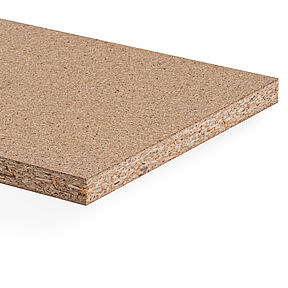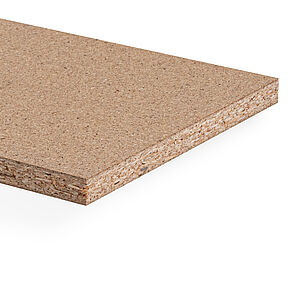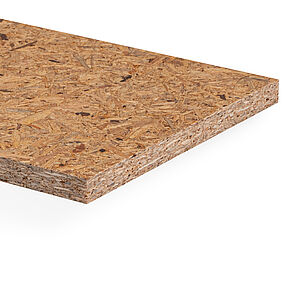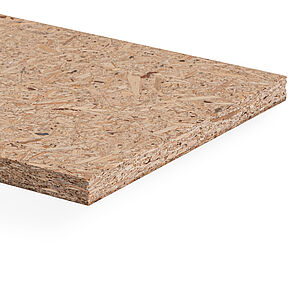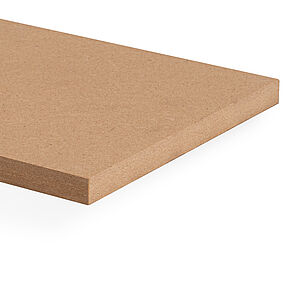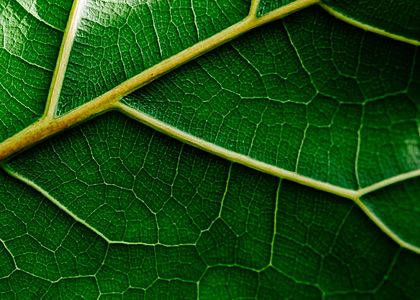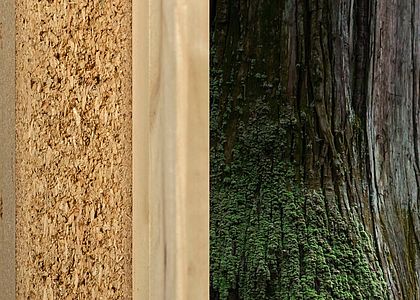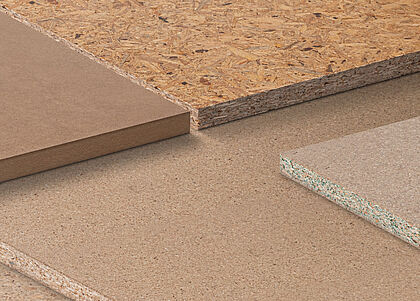What does sustainable construction mean? – The definition
At its core, sustainable construction or green building aims to use materials and methods that promote sustainable and environmentally friendly solutions. This includes, among others, the use of renewable and recyclable sustainable building materials, energy-efficient construction techniques, and the reduction of emissions and waste throughout the entire life cycle and for every component of a building.
In light of climate change, the importance of sustainability in construction has grown significantly. Construction projects planned with sustainability in mind help reduce the environmental footprint while simultaneously contributing to long-term cost savings and an improved quality of life. After all, residential health is also a key parameter in the development of sustainable buildings.

Green building, smarter living: The benefits of sustainable construction at a glance
The reasons behind sustainable architecture extend far beyond environmental protection. Both residents and building managers benefit from numerous advantages:
- Healthy living environment: Enhanced indoor air quality through low-emission materials
The use of low-emission, eco-friendly building materials prevents the release of harmful substances, such as volatile organic compounds (VOCs), which are commonly found in paints, adhesives, and conventional composite panels. - Economic benefits: Long-term cost savings through energy efficiency
Sustainable buildings are noted for their high energy efficiency. In the long run, this reduces operating costs and diminishes reliance on energy resources. Additionally, potential incentives for sustainable construction projects further bolster the financial advantages. - Value appreciation: An environmentally friendly investment
At a time when sustainability and energy efficiency are increasingly valued, properties constructed using eco-friendly building methods and exhibiting lower energy consumption are in ever-growing demand on the market. This represents an attractive, resilient investment. - Environmental protection: reducing the ecological footprint
Eco-friendly materials, energy-efficient construction methods, and renewable energy sources help to reduce the consumption of natural resources and cut the emissions of climate-damaging gases. In doing so, sustainable construction makes a significant contribution to environmental protection and reduces the ecological footprint.
Ecological building starts here: An overview of the key guidelines
Ecological or “green” building aims to create structures that contribute sustainably to the preservation of the environment and the health of their occupants. It involves considering nature in every aspect – from raw material consumption to indoor air quality.
Features of Ecological Architecture
When discussing the features of ecological architecture, the overall concept is key. The construction process itself should be as resource-efficient and energy-efficient as possible. This includes using regional, natural, durable, and preferably renewable building materials, whose production requires minimal energy and water.
Moreover, environmentally friendly and ideally self-sufficient building utilisation is important. This is achieved through high-quality insulation systems, eco-friendly energy solutions, and rainwater harvesting installations.
Lastly, ecological architecture also entails a healthy indoor climate, which is ensured by using low-emission materials, natural lighting, and optimised temperature and humidity regulation.
Important: Ecological building is a continuous process rather than a static solution. It involves continuously adapting to new insights, technologies, and environmental conditions to ensure the most sustainable construction methods.
Construction Methods in Sustainable House Building
To implement the guidelines and features mentioned above, there are various construction methods particularly suited for sustainable house building:
- Timber Construction
Timber is a renewable and CO₂-neutral building material, making it ideal for sustainable construction. It utilises the natural insulation properties of the material, which minimises the need for additional insulation. Moreover, timber buildings are deconstructible and recyclable. - Straw Bale Construction
Straw bale construction – also known as timber frame construction with straw bales as insulation – is an ecological building method due to the use of renewable, locally sourced raw materials and its high energy efficiency. - Earthen Construction
Earthen construction is noted for its ability to regulate moisture, thereby creating a healthy and pleasant indoor climate. Since earth is often sourced locally, CO₂ emissions are kept to a minimum. Furthermore, unfired clay bricks require little energy to produce. For this reason, earth is used in traditional timber-framed houses as well as in modern projects for floors, walls, and plasters. - Masonry Construction
Ecological masonry construction utilises recycled or natural building materials such as clay bricks, sand-lime bricks, or porous bricks. The sustainability of these methods depends on factors such as the regionality of the materials, the thermal insulation strategy, and the recyclability of the building components.

What are sustainable building materials?
Sustainable building materials are those produced and used with consideration for environmental compatibility, sustainability, and health. They help to minimise resource consumption – this includes renewable and recyclable materials. They also reduce the energy required during production, transport, and disposal, and importantly, they do not emit pollutants that could affect the health of occupants.
Examples of bioarchitecture:
- Timber
- Clay
- Natural stone (granite, sandstone, limestone, slate, basalt, …)
- Natural paints and plasters without synthetic binders, solvents, or preservatives
- Biological insulation materials, such as:
- Wood fibre
- Cellulose
- Hemp
- Sheep’s wool
- Flax
- Cork
- Straw
- Coconut fibre
- Perlite
How to recognise sustainable building materials
Identify sustainable building materials by their recognised certifications and labels. These guide builders, planners, and architects in selecting environmentally friendly materials and ensure that high ecological standards are met.
Key bioarchitecture labels:
- Blauer Engel certifies environmentally friendly products that are manufactured resource-efficiently and are safe for health.
- Cradle to Cradle (C2C) promotes reusability and resource conservation.
- DGNB Certification considers the entire life cycle of a building, including operation and deconstruction.
- FSC (Forest Stewardship Council) guarantees that timber comes from sustainably managed forests and meets social standards.
- Natureplus is a European label with stringent ecological and social criteria.
- PEFC (Programme for the Endorsement of Forest Certification), similar to FSC, focuses on promoting sustainable forestry.
- Sentinel Haus Institut certifies products that are suitable for allergen-friendly and low-emission construction.
Learn more about the certifications and frameworks awarded to Pfleiderer products.
Timber as a Material – Examples of sustainable construction
When it comes to bioarchitecture, timber plays a central role. Timber is not only a natural resource but also a renewable one which, when managed through sustainable forestry practices, contributes significantly to environmental preservation. It sequesters CO₂, reduces the ecological footprint, and leaves no harmful residues. Furthermore, timber’s natural aesthetic and versatility enhance the overall living environment.
Pfleiderer is committed to recycling reclaimed wood and, in line with the principles of a circular economy, transforming it into high-quality, durable products. Our timber supply comprises:
- 50% post-consumer recycled wood
- 26% sawmill offcuts
- 24% thinning and felled wood
We source our timber from controlled forestry in Germany and neighbouring countries – ensuring the shortest possible transport routes and minimising emissions. Discover our innovative products and learn how they contribute to environmental protection.

Overview of Ecological Raw Boards at Pfleiderer
LivingBoard
LivingBoard is Pfleiderer’s range of sustainable particleboards and multilayer boards (P4, P5, P7, face contiprotect P5, face contiprotect P7). Thanks to its 100% formaldehyde-free adhesive, LivingBoard emits as little formaldehyde as natural timber. At the same time, these boards exhibit high bending strength in all directions, minimal thickness swelling, and a low rate of combustion.
Applications and Benefits
LivingBoard is suitable for interior wall and ceiling applications (usage class 1), while the P5 and P7 panels are designed for use in moisture-prone areas (usage class 2). In addition, LivingBoard panels are employed in structural applications such as timber frame construction, wood panel construction, or timber stud construction, as well as in formwork and packaging construction.
Awards
- Blauer Engel DE-UZ 76
- Cradle to Cradle Certified® Silver
- PEFC-certified
- Quality Label for Wood-Based Materials
- FSC-certified
- SHI Certificate
- … and others for individual LivingBoard panels
Production Hall Timber Homes, Dorfen (2023)
For the construction of the “Timber Homes” production hall, building materials that were already present on the site—a former brickworks—were reused. In line with the circular economy concept, LivingBoard panels certified with the silver Cradle to Cradle label were also installed.
Products used from Pfleiderer:
- LivingBoard face contiprotect P7
Learn more about Timber Homes production hall
PremiumBoard MFP Living P5
PremiumBoard MFP Living P5 is a particle board that combines several benefits: mechanical strength, stability, and load-bearing capacity. A high recycled content and formaldehyde-free bonding ensure resource-efficient production.
Applications and Benefits
PremiumBoard MFP Living P5 is used in structural applications, for instance in sustainable timber construction. Additionally, the board is also suitable for formwork and packaging construction
Awards
- Blauer Engel DE-UZ 76
- FSC-certified
- PEFC-certified
- QNG Ready Label
- SHI Certificate
Student Accommodation in Timber Module Construction, Pessac
The entire student residence in Pessac, France, has been built using timber modules. The prefabrication of these modules saves energy and reduces environmental impact. Moreover, the architects have chosen PremiumBoard MFP Living P5 for its low emissions and sustainable properties.
Products used from Pfleiderer:
• PremiumBoard MFP Living P5
StyleBoard MDF.RWH
Among Pfleiderer’s MDF boards – under the StyleBoard range – is the diffusion-open, formaldehyde-free bonded board MDF.RWH. This naturally-finished fibreboard supports the regulation of moisture in buildings, reduces the risk of mould growth, and is fully recyclable.
Applications and Benefits
StyleBoard MDF.RWH is designed for roof and wall decking in timber construction. Its precise tongue and groove design makes it popular in installation, allowing for a flat and flush finish.
Certifications
- FSC-certified
- PEFC-certified
Showhouse – Friedl Holzbau, Obersüßbach (2023)
At Friedl Holzbau, bespoke timber houses are built to measure. To give customers the opportunity to gain a better insight into the construction method, a showhouse is now available where Friedl Holzbau’s high standards for sustainability and indoor air quality have been realised. Instead of conventional OSB boards, LivingBoard panels have been used for ceilings and wall cladding, with their reduced emission levels enhancing residential health. StyleBoard was chosen as the underlay panel, impressing with its outstanding dimensional accuracy.
Products used from Pfleiderer:
• LivingBoard face contiprotect P5
• StyleBoard MDF.RWH

The ecological future of sustainable construction
Sustainable construction is not only an environmentally sound response to climate change but also a forward-thinking principle that combines ecological, economic, and health benefits. Newly developed technologies and natural building methods are setting the benchmark for eco-friendly structures, while innovative products like LivingBoard, PremiumBoard, and StyleBoard support the circular economy.
Discover the entire Pfleiderer product range – and design sustainable buildings with eco-friendly timber products for structural, interior, and exterior applications!

